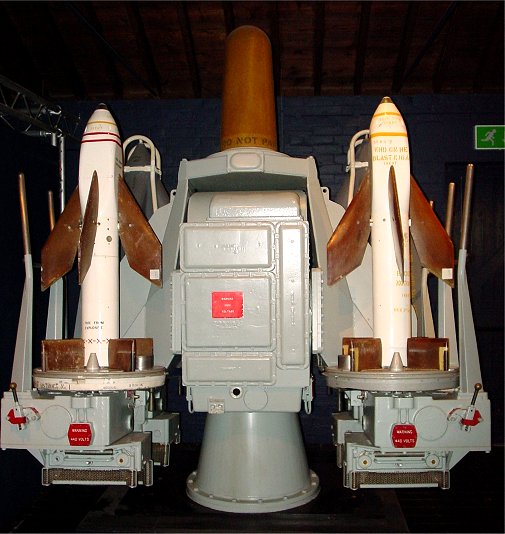
The Falklands War
Budget cuts in the Royal Navy reduced the quality and quantity of the British Royal Navy in the late 1970s.(English 32) Embarrassing losses occurred as a result in the 1982 Falklands War.
Upon the aging of Britain's conventional aircraft carriers, they were replaced by small anti-submarine carriers with at most 18 helicopters and 12 airplanes each. (Hastings 346) The vertical takeoff Harrier was used in the Falklands conflict and was a good dogfighter, but it was inferior in range. The Harrier had a range of only 250 miles on attack missions compared to a maximum range of 1,600 miles of the Argentinean Pucara. (354) The radar used on the Harrier was not suited for the air-superiority mission it was given and was unable to detect aircraft flying at low levels over land or sea. (Braybrook 10) The small carriers were not equipped with airborne early warning aircraft which use sophisticated radars to detect enemy aircraft and coordinate their interception. (Grimes 57) As a result, little could be done to stop Argentine attacks with the sea-skimming Exocet anti-ship missile.
 |
| Exocet Missile |
On May 4, 1982, two Argentinean Super Etendard aircraft skimmed the ocean surface, avoiding the two British Harriers on combat air patrol and located the task force. Two Exocet missiles were launched, one of which devastated the HMS Sheffield. (Miller 196-7) On May 25, 1982, a low level Exocet attack was launched with the intention of sinking the two British carriers. Once again the Harrier combat air patrol failed to intercept the attack. However, the British had placed the carriers in a less obvious position, so the Argentines unknowingly sank the Atlantic Conveyor, a transport carrying the helicopters the ground forces planned on using for airmobile operations. (199) It is unlikely the British could have continued the war with the loss of one of its two carriers, and indeed they were quite lucky the Argentines had only a half dozen Exocets.
The task force was also unable to deal with attacks from the 1950s vintage A-4 Skyhawk dropping conventional bombs. Skyhawks attacked the landing force at San Carlos sinking the HMS Ardent and damaging the HMS Antrim. Later attacks damaged the landing ships Sir Bedivere, Sir Galahad, HMS Glasgow, and destroyed the HMS Antelope. (Dublin 32-3) On May 24th and 25th, air attacks damaged two supply ships, the Argonaut, the Broadsword, and sank the Coventry. (English 28-9) Many of the damaged vessels were hit with bombs which failed to explode because they did not have time to arm properly. Had these bombs detonated, the amphibious landings would have been a complete disaster.
Many of the ships' weapons systems were not effective. Hundreds of anti-submarine weapons were fired at sonar contacts, but the one Argentine submarine in the area was not sunk. (Hughes 236) British Type 42 destroyers were armed with Sea Dart medium range anti-aircraft missiles whose ancient vacuum tubes required warm up time before launch, making them useless against surprise Exocet attacks. The obsolete Sea Cat anti-aircraft missile was guided by crewmen who relied on visual contact, and the close-in anti-aircraft weapons were also obsolete. (English 135) Only two anti-aircraft Type 22 ships with their effective Sea Wolf missile system protected the vital carriers. (Miller 197)
 |
 |
| Seacat Missile System | Chaff Launchers - created clouds of aluminum foil to send Exocets off target |
On the whole, the Royal Navy was inadequate for the task, equipped with inadequate and often obsolete weapons. The Harriers shot down twenty Argentine aircraft while no Harriers were lost to enemy aircraft. (Braybrook 29) But the British had only twenty Harriers available and could not deal with the over 180 planes in the Argentine inventory. (Argentina A2) Ships of the Royal Navy shot down only 10% of the Argentine Air Force, (Hughes 162) but 75% of the British task force was damaged or sunk. (English 33) Surprisingly, luck made up for these deficiencies, and fortune favored the brave of the United Kingdom.
Works Cited
"Argentina Said to Avoid Britain's Blockade Zone." The New York Times 1 May 1982: A2
Braybrook, Roy. Battle for the Falklands (3): Air Forces. Men-at-Arms Series. Ed. Martin Windrow. London: Osprey, 1982
Dublin, Peter B. "Determined Attack From Bomb Alley." Military History Magazine Apr. 1986: 30-36.
English, Adrian, and Anthony Watts. Battle for the Falklands (2): Naval Forces. Men-at-Arms Series. Ed. Martin Windrow. London: Osprey, 1982.
Grimes, Vincent. "Five Planes in One?" International Combat Arms Mar. 1989: 57.
Hastings, Max, and SImon Jenkins. The Battle for the Falklands. New York: W.W. Norton, 1983.
Hughes, Wayne P. Fleet Tactics: Theory and Practice. Annapolis: Naval Institute Press, 1986
Miller, David, and Chris Miller. Modern Naval Combat. New York: Crescent Books, 1986.
"U.S. Admiral Calls British Naval Cuts an Error." The New York Times 22 May 1982: A7.